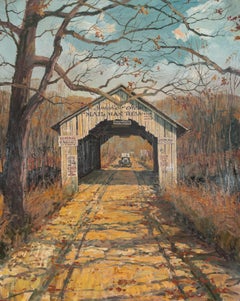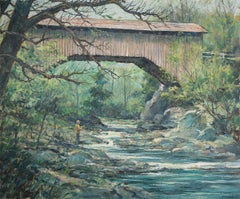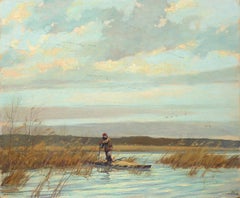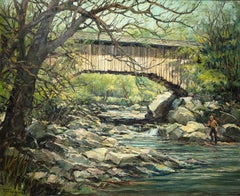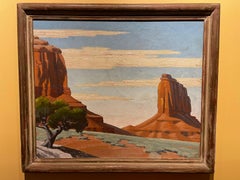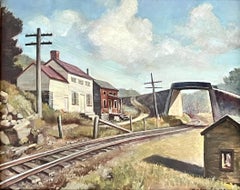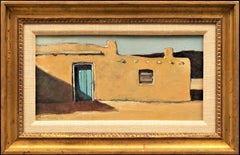Eric Sloane Landscape Paintings
to
5
3
4
1
1
2
1
1
Overall Height
to
Overall Width
to
4
4
4
3
3
3
2
2
2
1
1
1
1
1
1
1
1
1
4
1
5
555
251
227
177
5
5
Artist: Eric Sloane
Cornwall Bridge
By Eric Sloane
Located in New York, NY
Cornwall Bridge
Oil on canvas
30 ½ x 24 ¾ inches unframed (77.47 x 62.865 cm)
Signed and inscribed (Cornwall Bridge Conn) on reverse
Description:
Eric Sloane is best known for his illustrations of "americana," and, throughout his life, devoted himself to painting this American world. This painting, titled "Cornwall Bridge," is included in one of his travel books...
Category
20th Century Hudson River School Eric Sloane Landscape Paintings
Materials
Oil
Fishing Below a Covered Bridge, Vermont
By Eric Sloane
Located in New York, NY
Inscribed lower left: [WEST]FORD BRIDGE / [CA]MBRIDGE VT; signed lower right: SLOANE
Category
20th Century American Modern Eric Sloane Landscape Paintings
Materials
Oil
Forest Interior
By Eric Sloane
Located in New York, NY
Signed and inscribed lower left: ERIC SLOANE N.A.
Category
20th Century American Modern Eric Sloane Landscape Paintings
Materials
Oil
December Morning
By Eric Sloane
Located in New York, NY
Signed lower right: –SLOANE; inscribed lower left: DECEMBER MORNING
Category
21st Century and Contemporary American Modern Eric Sloane Landscape Paintings
Materials
Oil
Spring in Cambridge, Vermont
By Eric Sloane
Located in New York, NY
Signed lower right: SLOANE; inscribed lower left: SPRING IN / CAMBRIDGE VERMONT; on verso: — ERIC SLOANE / BROOKFIELD / CONN
Category
20th Century American Modern Eric Sloane Landscape Paintings
Materials
Oil
Related Items
Vintage Modernist Landscape Painting, Monument Valley Arizona, listed artist
Located in Baltimore, MD
Although born in Ohio at the end of the 19th century, Martin Sabransky studied art at Randolph Macon College in Virginia. He began his career path moving west, by first going to Kans...
Category
Mid-20th Century American Modern Eric Sloane Landscape Paintings
Materials
Oil
Untitled (Houses and Railroad Tracks)
By Harry Lane
Located in Los Angeles, CA
Untitled (Houses and Railroad Tracks), c. 1940s, oil on canvas board, signed lower right, 16 x 20 inches, presented in a newer frame
This work is part of our exhibition America Coas...
Category
1940s American Modern Eric Sloane Landscape Paintings
Materials
Oil, Board
Landscape
By Asher Brown Durand
Located in Fredericksburg, VA
This is a beautiful landscape done by the famous Hudson River School artist, Asher Brown Durand. Asher B. Durand began his art career following his father in engraving. He was one of...
Category
Mid-19th Century Hudson River School Eric Sloane Landscape Paintings
Materials
Oil, Canvas
Untitled (Farm in Winter)
By Julius M. Delbos
Located in Los Angeles, CA
This work is part of our exhibition America Coast to Coast: Artists of the 1940s
Untitled (Farm in Winter), 1940s, oil on canvas, signed lower right, 26 x 30 inches, presented in a...
Category
1940s American Modern Eric Sloane Landscape Paintings
Materials
Canvas, Oil
My Only Working Tool
Located in Los Angeles, CA
My Only Working Tool, 1949, oil on panel, signed and dated lower right, 16 x 12 inches, remnant of exhibition label verso, exhibited at the Art News Second Annual National Amateur Co...
Category
1940s American Modern Eric Sloane Landscape Paintings
Materials
Oil, Board
Trees at Bloom
By Clarence Holbrook Carter
Located in Los Angeles, CA
Trees at Bloom, 1939, oil on canvas, 32 x 24 inches, signed lower right
About the Painting
Trees at Bloom was painted when Clarence Holbrook Carter lived in Pittsburgh and served as an instructor in the Department of Painting and Design at the Carnegie Institute of Technology (now Carnegie-Mellon University), a position he held from 1938 through 1944. It depicts a thick forest at the base of distance hills just outside the city. During his tenure in Pittsburgh, Carter was deeply influenced by not only the industrial might of the steel mills and iron forges of the city, but also the beauty of the surrounding landscape. As Frank Anderson Trapp noted in his book on the artist, for Carter “the terrain itself had its own special vitality, with its craggy, wooded hills threaded with ravine and watercourses . . . . the signs of industrial blight that were unalleviated in some parts of the country were there relieved by the geological variety of the parent landscape, and by the irrepressible presence of its natural growth, which softened the whole.” Trapp continues, “in his scenes of rural situations, Carter had a special gift for rendering those elements convincingly.” With the profusion of flowering trees which diffuse the light and the red cardinals darting from one branch to another, Trees at Bloom portrays the “irrepressible presence of nature” that Trapp describes.
About the Artist
Together with Charles Burchfield, Clarence Holbrook Carter was Ohio’s premiere American Scene painter and later an innovative magic realist. The son of a no-nonsense public-school administrator, Carter was born in 1904 outside of Portsmouth, Ohio, a small town in the heart of the Ohio River...
Category
1930s American Modern Eric Sloane Landscape Paintings
Materials
Canvas, Oil
"Concert" Early 20th Century WPA Modernism American City Landscape Scene Ashcan
By Michael Loew
Located in New York, NY
"Concert" Early 20th Century WPA Modernism American City Landscape Scene Ashcan
The size of the canvas 28 3/4 x 43 1/4 inches. The painting comes directly from the artist's estate. It is signed lower right as well as signed, titled and dated verso.
We have available more than two dozen paintings and works on paper from the 1930s - 80s that come directly from the Loew estate.
BIO
Michael Loew (1907 – 1985) was the son of a New York City baker. After high school, he was an apprentice to a stained-glass maker, and from 1926-1929, he studied at the Art Students League. In 1929, he traveled to Paris, North Africa, Germany, and Italy with a group of artists. When he returned to New York City in 1931, the Great Depression hit Loew unexpectedly, and for the next two years he paid his apartment rent with his paintings. In 1935, he found work with the WPA where he painted murals and partnered up with longtime friend Willem de Kooning in 1939 on a mural for the Hall of Pharmacy at the New York World’s Fair. Their friendship lasted for the rest of their lives. In the mid-30’s he painted in Mexico and the Yucatán documenting the construction of a U.S. Naval airbase on Tinian Island. It was from this airbase that the Enola...
Category
1920s American Modern Eric Sloane Landscape Paintings
Materials
Canvas, Oil
Jefferson Market Library (Courthouse)
Located in Los Angeles, CA
This painting is part of our exhibition America Coast to Coast: Artists of the 1930s
Jefferson Market Library (Courthouse), c. 1930s, oil on canvas, 30 x 24 inches, signed lower right; presented in a newer silver painted frame
About the Painting
Writing about an exhibition of Charles W. Adams’ work at the Eighth Street Art Gallery in the mid-1930s, Emily Grenauer observed in The World-Telegram that the artist’s paintings were “distinguished for their solid form, well organized design and sumptuous color” and the art critic for The Herald Tribune found Adam’s work “a strong, formal realization of his subject . . . he paints with vital emphasis on structure and composition.” Although we do not know which works these critics referenced, it is likely they were writing about paintings like Jefferson Market Library (Courthouse). With its carefully designed reality, strong angles, solid forms, and well-disciplined puffs of smoke in the background, Adams presents a highly structured version of the Greenwich Village landmark, the Jefferson Market Library, which was a courthouse at the time Adams completed this work. The Jefferson Market Library was a prized subject for downtown painters, including the Ashcan School painter, John Sloan, the modernist, Stuart Davis, and the precisionist, Francis Criss...
Category
1930s American Modern Eric Sloane Landscape Paintings
Materials
Oil
Bay of New York at Sunrise, 1875
By Edward Moran
Located in New York, NY
Edward Moran paints a scenic coastal scene of ships setting out into the Bay of New York at the beginning of day in his artwork entitled, “ Bay of New York at Sunrise”
Category
Late 19th Century Hudson River School Eric Sloane Landscape Paintings
Materials
Oil, Board
Six O'Clock
Located in Los Angeles, CA
Six O-Clock, c. 1942, oil on canvas, 30 x 20 inches, signed and titled several times verso of frame and stretcher (perhaps by another hand), marked “Rehn” several times on frame (for the Frank K. M. Rehn Galleries in New York City, who represented Craig at the time); Exhibited: 1) 18th Biennial Exhibition of Contemporary American Oil Paintings from March 21 to May 2, 1943 at The Corcoran Gallery of Art in Washington, D.C. #87, original price $450 (per catalog) (exhibition label verso), 2) Craig’s one-man show at the Frank K. M. Rehn Galleries, New York City, from October 26 to November 14, 1942, #10 (original price listed as $350); and 3) Exhibition of thirty paintings sponsored by the Harrisburg Art Association at the State Museum of Pennsylvania in Harrisburg in March, 1944 (concerning this exhibit, Penelope Redd of The Evening News (Harrisburg, Pennsylvania) wrote: “Other paintings that have overtones of superrealism inherent in the subjects include Tom Craig’s California nocturne, ‘Six O’Clock,’ two figures moving through the twilight . . . .” March 6, 1944, p. 13); another label verso from The Museum of Art of Toledo (Ohio): original frame: Provenance includes George Stern Gallery, Los Angeles, CA
About the Painting
Long before Chris Burden’s iconic installation outside of the Los Angeles County Museum of Art, Urban Light, another artist, Tom Craig, made Southern California streetlights the subject of one of his early 1940s paintings. Consisting of dozens of recycled streetlights from the 1920s and 1930s forming a classical colonnade at the museum’s entrance, Burden’s Urban Light has become a symbol of Los Angeles. For Burden, the streetlights represent what constitutes an advanced society, something “safe after dark and beautiful to behold.” It seems that Craig is playing on the same theme in Six O-Clock. Although we see two hunched figures trudging along the sidewalk at the end of a long day, the real stars of this painting are the streetlights which brighten the twilight and silhouette another iconic symbol of Los Angeles, the palm trees in the distance. Mountains in the background and the distant view of a suburban neighborhood join the streetlights and palm trees as classic subject matter for a California Scene painting, but Craig gives us a twist by depicting the scene not as a sun-drenched natural expanse. Rather, Craig uses thin layers of oil paint, mimicking the watercolor technique for which he is most famous, to show us the twinkling beauty of manmade light and the safety it affords. Although Southern California is a land of natural wonders, the interventions of humanity are already everywhere in Los Angeles and as one critic noted, the resulting painting has an air of “superrealism.”
About the Artist
Thomas Theodore Craig was a well-known fixture in the Southern California art scene. He was born in Upland California. Craig graduated with a degree in botany from Pomona College and studied painting at Pamona and the Chouinard Art School with Stanton MacDonald-Wright and Barse Miller among others. He became close friends with fellow artist Milford Zornes...
Category
1940s American Modern Eric Sloane Landscape Paintings
Materials
Canvas, Oil
Abstract Street (Untitled)
By Hananiah Harari
Located in Los Angeles, CA
This painting is part of our exhibition America Coast to Coast: Artists of the 1930s
Abstract Street (Untitled), 1939, oil on canvas, signed and dated lower right, 12 x 32 inches; provenance includes a private collection in Venice, California; presented in what is likely the artist's original handmade frame
About the Painting
The present work is the culmination of a series of mainly horizontal urban abstractions Harari completed between 1937 and 1939. Deeply influenced by Stuart Davis, Harari’s New York streetscapes began with clearly recognizable objects and landmarks as in Into New York (1937 - Collection of the Whitney Museum of American Art), New York Harbor (1937), Up and Downtown (1938), and his other mural proposals for the Nurses Home on Welfare Island (1937) and the Williamsburg Housing Project (1938). At the end of the series, Harari’s vistas became increasingly abstract with broad planes of color representing buildings and streets, the slightest cross-hatching forming a bridge or elevated train track and the vague suggestion of a streetlight looping in the right center of the composition. Figures, birds, and a street vendor’s cart are reduced to pictograms scratched into the surface of the canvas. Abstract Street (Untitled) is among Harari’s most spare works of the 1930s and 1940s and calls to mind the seemingly childlike, but deeply sophisticated works of Paul Klee from the 1920s. It serves as an excellent reminder of why Harari was heralded as one of the earliest members of the American Abstract Artists.
About the Artist
Hananiah Harari was an artistic polyglot who was equally at home working in styles as diverse as Cubism, Constructivism, Expressionism, Hard Edged Abstraction and trompe l’oeil Realism. A native of Rochester, New York, Harari initially studied as a child at the Memorial Art Gallery in his hometown and later as a scholarship student at the College of Fine Arts at Syracuse University. In 1932, Harari left for Paris where he befriended Nahum Tschacbasov, Benjamin Benno and John Graham and studied at the ateliers of Lhote, Leger and Gromaire. He also studied fresco painting at the Ecole de Fresque. By 1933, Harari had completed enough work and gained a sufficient reputation to have a solo exhibition at the American Club in Paris. The following year, Harari and his childhood friend and fellow artist Herzl Emanuel traveled to Palestine, where the artists worked hard in the orchards and fields of Kibbutz Deganiah, but produced little art. After returning to New York, Harari married Emanuel’s sister, Freda, and set out on the development of what noted scholar Gail Stavitsky has called an “original synthesis of the old and new." Harari became an early member of the American Abstract Artists (AAA), an organization formed to give modernists exhibition opportunities. Harari was also a member of the socially conscious Artist’s Union and the American Artist’s Congress. From 1936 through 1942, Harari worked on the Federal Art Project and assisted Marion Greenwood on a project as part of the Mural Division, but to his disappointment did not lead his own project. During the late 1930s and early 1940s, Harari completed a series of paired paintings with the same subject matter depicted in a Cubist manner and in trompe l’oeil Realism. Harari was acclaimed by Clement Greenberg and six of the artist’s works were selected for the Museum of Modern Art’s important 1943 exhibition American Realists and Magic Realists. During World War II, Harari served in the US Army Air Corps. Following the war, Harari continued to produce fine art while also producing commercial art. During the McCarthy Era, Harari’s progressive politics and leftist leaning art...
Category
1930s American Modern Eric Sloane Landscape Paintings
Materials
Oil
Reminiscence of Vermont, ca. 1860–1870
By William Hart
Located in New York, NY
In this detailed and colorful rendering of a Vermont countryside entitled “Reminiscence of Vermont,” William Hart paints two figures walking along a stream
Category
19th Century Hudson River School Eric Sloane Landscape Paintings
Materials
Oil, Board
Previously Available Items
Taos Adobe-Eric Sloane (American, 1905-1985)
By Eric Sloane
Located in SANTA FE, NM
Taos Adobe
Eric Sloane (American, 1905-1985)
Oil on board
Signed front and back
6 1/2 x 13 (11 1/2 x 18 frame) inches
Artist, author and folklorist, Eric Sloane, is best known for his paintings of New England farmscapes and his illustrated books of early Americana. As a visitor and eventual resident of New Mexico, he also is considered an important artist of the Southwest.
Sloane was born Everard Jean Hinrichs to a prosperous family in New York City. As a youngster, he learned lettering and sign painting from his neighbor, Frederic Goudy, a noted type designer. In 1925 Hinrichs left home in a Model T Ford, and made his way across the country earning money as a sign painter. The next year he landed in Taos where he met members of the art colony, painted signs, as well as a few of his earliest pictures.
Back in New York, Hinrichs continued his sign painting career. Among his clients were many of the early aviation pioneers at Roosevelt Field, Long Island who asked him to paint names and identifying marks on their aircraft. Wiley Post not only was a client, but also taught Hinrichs to fly, instilling a life-long love of the aesthetics and science of clouds and sky. Amelia Earhart is said to have purchased one of his first cloud paintings.
In the mid-1930s Hinrichs studied at the Art Students League under John Sloan. As part of his transformation from sign painter to fine artist, he adopted the name “Sloane” in homage to his mentor, and the name Eric from the middle letters of “America.”
Settling in New Milford, Connecticut, Sloane quickly became a highly skilled and phenomenally prolific painter of the rural landscapes and colonial architecture of New England. He painted in a detailed, realistic style with a slightly choppy brush technique that enhanced the rustic quality of his subject matter. Slone reportedly painted 15,000 pictures over his career, averaging almost one per day.
In the early 1940s, Sloane’s interest in meteorology resulted in publication of several books on weather and clouds. In the 1950s he began his meticulous documentation of colonial architecture, tools, and folklore, resulting in a series of books that he both wrote and illustrated. The most famous of these include: A Reverence for Wood, Our Vanishing Landscape, A Museum of Early American Tools, American Barns and Covered Bridges, and Diary of an Early American Boy: Noah Blake – 1805. In all, Sloane produced 35 books, many of which are still in print. His vast collection of tools, which served as models for many illustrations, became the nucleus of the Sloane-Stanley Tool...
Category
1960s American Realist Eric Sloane Landscape Paintings
Materials
Oil, Board
Winter Mountain Landscape with Skier
By Eric Sloane
Located in Milford, NH
A fine winter landscape with a skier enjoying solitude on a mountain run by American artist Eric Sloane (1905-1985). Sloane was born Everard Jean Hinrichs in New York City and took a...
Category
Mid-20th Century American Impressionist Eric Sloane Landscape Paintings
Materials
Canvas, Oil
Lone Summer Rider
By Eric Sloane
Located in Milford, NH
A fine landscape with a cowboy on horseback riding the ridge with powerful clouds behind him by American artist Eric Sloane (1905-1985). Sloane was born Everard Jean Hinrichs in New York City and took an early interest in art, spending many boyhood hours with neighbor and noted font inventor Frederic Goudy. From Goudy, he learned to hand paint letters and signs. He established several aviation clients from Roosevelt Field, Long Island, painting the identifying marks on their planes. From these connections, he learned to fly and developed his love for clouds and sky from this newfound passion. One of his early clients, Amelia Earhardt, purchased his first cloud painting, and Sloane is said to be the finest cloud painter of his generation. His largest cloud painting graces the entire wall of the Smithsonian Air and Space Museum in Washington, DC. Sloane is also known as being the foremost authority on early American rural architecture and early American tools, with many books published on each subject. Oil on masonite, signed lower left, titled on verso “Lone Summer Rider,” inscribed “Fenn Gallery, Santa Fe” on verso and frame, and framed in a complimenting barn board...
Category
Late 20th Century Realist Eric Sloane Landscape Paintings
Materials
Masonite, Oil
Ahead of the Weather
By Eric Sloane
Located in Buffalo, NY
An oil on board by Eric Sloane (1910-1985). Titled "Ahead of the Weather", circa 1940. Signed lower right. Housed in a gold gilt frame. Image size, 19"L x 13"H.
Eric Sloane wa...
Category
1930s American Impressionist Eric Sloane Landscape Paintings
Materials
Canvas, Oil
Eric Sloane landscape paintings for sale on 1stDibs.
Find a wide variety of authentic Eric Sloane landscape paintings available for sale on 1stDibs. Not every interior allows for large Eric Sloane landscape paintings, so small editions measuring 24 inches across are available. Customers who are interested in this artist might also find the work of Henry Martin Gasser, Frank Wilcox, and Stan Brodsky. Eric Sloane landscape paintings prices can differ depending upon medium, time period and other attributes. On 1stDibs, the price for these items starts at $14,000 and tops out at $37,500, while the average work can sell for $27,500.
